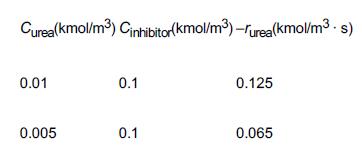Question: a. Wolfram and Python i. Explain how I would change if the concentrations of CS 2 and M were increased. ii. Explain how the light
a. Wolfram and Python
i. Explain how I would change if the concentrations of CS2 and M were increased.
ii. Explain how the light intensity varies with an increase in concentration of M.
iii. Write two conclusions from your experiment in (i)–(ii).
b. Wolfram and Python
i. At very low values of KM in the Michaelis–Menton plot (e.g., KM = 0.0001), how does the rate of substrate consumption, –rS, vary with substrate concentration, Curea?
ii. At very low values of KM in the Eadie–Hofstee plot, what are the values of KM and Vmax such that the substrate rate, –rS, becomes zero?
iii. Write two conclusions from your experiment in (i)–(ii). Polymath
iv. The following additional runs were carried out when an inhibitor was present:
What type of inhibition is taking place?
v. Sketch the curves for no inhibition as well as competitive, uncompetitive, noncompetitive (mixed), and substrate inhibition on a Woolf–Hanes plot and on an Eadie–Hofstee plot.
c. Wolfram and Python
i. As the conversion approaches one, what does the reaction time, in seconds, approach?
ii. What happens to X versus t when KM is varied?
iii. Vary each parameter and write a set of conclusions.
Polymath
iv. What would the conversion be after 15 minutes if the initial concentration of urea were increased by a factor of 10?
v. What is the minimum value of KM so that conversion is below 0.5 after half an hour?
d. What is the total mass of substrate consumed in grams per mass of cells plus what is consumed to form
product? Is there disparity here?
e.Wolfram and Python
i. Which parameter will you vary so that CC goes through a maxima at t = 9 hr? Explain the results.
ii. What is the minimum value of KS such that CS is always higher than Cp?
iii. What is the maximum value of μmax so that rg continuously increases up to t = 12 hr?
iv. What is the value of YS/C such that virtually 100% conversion is achieved at the end of the reaction?
v. Write a set of conclusions based on your experiment (i)–(iv) above.
Polymath
vi. Modify the code to carry out the fermentation in a fed-batch (e.g., semibatch) reactor in which the substrate is fed at a rate of 0.5 dm3/h and a concentration of 5 g/dm3 to an initial liquid volume of 1.0 dm3 containing a cell mass with an initial concentration of Cci = 0.2 mg/dm3 and an initial substrate concentration of Cci = 0.5 mg/dm3. Plot and analyze the concentration of cells, substrate, and product as a function of time, along with the mass of product up to 24 hours.
vii. Repeat (i) when the growth is uncompetitively inhibited by the substrate with KI = 0.7 g/dm3.
viii. Set Cp*=10000 g/dm3, and compare your results with the base case.
f.Enzyme Inhibition.
i. Vary Vmax and Km between their minimum and maximum values and describe what you find.
ii. Vary KI and describe how each of the three types of inhibition is affected.
iii. Write three conclusions based on your experiments in (i) and (ii).
g. This problem is a gold mine for things to be learned about the effect of alcohol on the human body.
i. Write a summary paragraph describing what you learned from reading the article.
Wolfram and Python
ii. Vary the initial concentration for ethanol in the stomach and describe how the concentrations of ethanol and acetaldehyde in the blood are affected.
iii. Set Vmax for acetaldehydes between 10% and 50% of its normal value and compare the concentration-time trajectories with the base cases.
iv. Write two conclusions about alcohol metabolism.
Curea(kmol/m) Cinhibitor(kmol/m)-urea(kmol/m.s) 0.01 0.005 0.1 0.1 0.125 0.065
Step by Step Solution
3.38 Rating (160 Votes )
There are 3 Steps involved in it
a i The intensity increases with an increase in CS 2 and M for both the cases presence and absence of Alcohol ii Intensity increases with increase in concentration of M iii 1 Intensity in presence of ... View full answer

Get step-by-step solutions from verified subject matter experts


